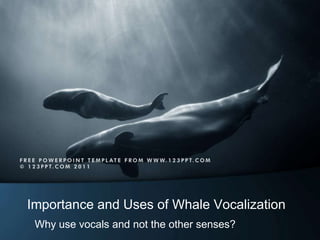
Presentation1
- 1. Importance and Uses of Whale Vocalization Why use vocals and not the other senses?
- 2. Physical Needs Social Needs Identity Needs Practical Goals All in all to express ourselves The Need for Communication
- 3. Sight + Smell not effective underwater Sound is the key Large number of whale species use “sounds” to communicate Adapted over time Produce large array of clicks, whistles, yells Produce from larynx and phonic lips Put together = Whale “songs” Primary Whale Communication
- 4. Sight irrelevant underwater Vocalization important Other ways to attract mates: Use of tail/flippers Chasing Male-male competition Sing “songs” Humpback whale song is the most famous Oleson et al; 2007 Primary use -> during mating season Sung by males Blue whale songs increase during mating season Sexual Selection
- 5. Echolocation Prey -> foraging Predators Each other Sung during migration Keep groups of whales together Blue, Fin, Toothed, Humpback whales Ward off predators Other Uses
- 6. Regional acoustic differences Blue, orca, sperm, humpback Interspecies Variation 9 different calls 4 in Pacific, 3 in Indian, 1 in Southern and 1 in Atlantic ocean Population boundaries Assess: Population structure Migration routes Habitats Behaviours Evolutionary processes Vocalization differences
- 7. Human interference Initially stop calling Increase physical activity Nudging, rubbing, chasing Adaptations Increase frequency + amplitude Increase call duration Increase number of calls Shifting times Clark; 2010 Foote et al; 2004 Anthropogenic interference
- 8. Vocalization useful underwater Sexual selection Various other purposes Echolocation Migration Regional acoustic differences Population boundaries EVOLUTION OF VOCALIZATION IS USEINFUL IN WHALES Conclusion
- 9. THANK YOU :D